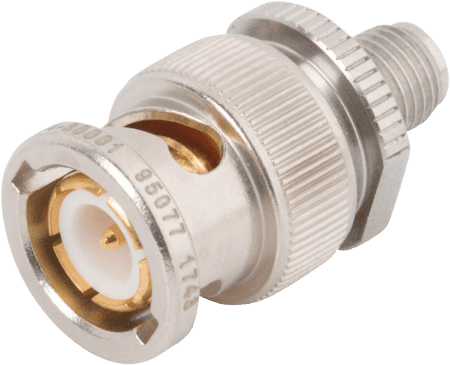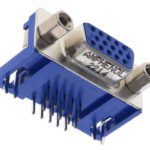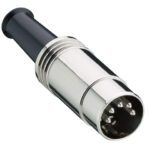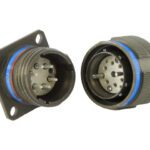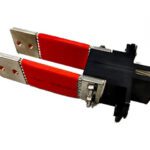What are BNC Connectors?
Meet the Connector: BNC Connectors
BNC connectors are miniature radio frequency (RF) connectors developed for low-frequency applications. This quick-connect/disconnect circular connector features a two-stud bayonet-style locking mechanism that users twist and snap into position. A tactile snap indicates a secure connection; a reverse motion disconnects the connector pair.
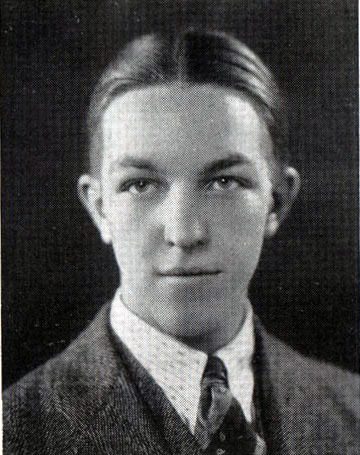
Carl Concelman
The BNC connector famously bears the initials of its creators, Paul Neill of Bell Laboratories and Carl Concelman of Amphenol. However, there is some variation in this definition: “B” is generally believed to stand for the bayonet locking mechanism (Bayonet Neill Concelman), although some say it stands for “baby” (Baby Neill Concelman), a reference to the connector’s small size and use with small coaxial cable diameters. Other variations of the name include Baby N Connector, Baby Neill Constant, and British Naval Connector. (Connector Supplier prefers to honor the originators of this important product category and uses “Bayonet Neill Concelman.”)
Neill also developed the N connector and Concelman developed the C connector; together they created the TNC connector — the Threaded Neill Concelman. Octavio Salati of Hazeltine Electronics Corporation filed the patent for the BNC in 1945 (patent #2,540,012), integrating the bayonet features of the N connector with the slim format of the C connector, and crediting those inventors in the name.
Design Notes
Standardization: CECC 22121, IEC 61169-8, MIL-STD-348B.
Impedance: 50 or 75 ohms
Voltage: Under 500 volts
Dielectric Withstanding Voltage: 1500 VRMS
Frequency Range: Originally for DC to 1 GHz, today versions are available for 11 and 18 GHz.
Mating Cycles: 500
Temperature Range: -65 ° to 165 °C
Mating Style: Bayonet
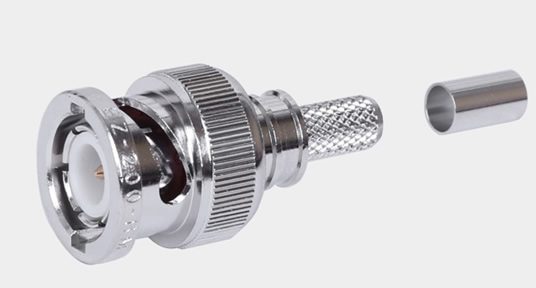
Time Microwave’s BNC offerings include this SZ-200-BM-X connector
Shielding: Twin, or twinax, BNC connectors use the same bayonet latching shell as an ordinary BNC connector but contain two independent contact points (one male and one female), allowing the connection of a 78 ohm or 95 ohm shielded differential pair such as RG-108A.
Dimensions: The outer diameter of the interface is approx. 0.570 in (14.5 mm); male 0.436 in (11.1 mm), female. Miniature and subminiature versions are available from some suppliers.
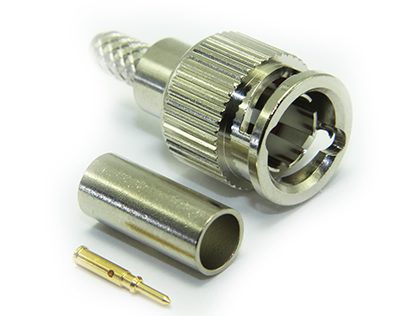
COAX Connectors offers standard BNC as well as miniature BNC connectors like this Mini BNC Crimp Plug, which is 40% smaller and can be mounted on a 14 mm pitch.
Polarity variation: The male connector is typically fitted to a cable and the female connector is affixed to a panel. A variation known as a reverse-polarity BNC (RP-BNC) reverses the polarity of the interface: The female contact normally found in a jack is usually in the plug, while the male contact normally found in a plug is in the jack. This ensures that RP-BNC connectors are not operable with standard interface connectors.
Other options: BNC connectors are available with a wide range of variations and special features, including non-magnetic, hermetically sealed, various plating and housing materials, and flexible and semi-rigid coaxial cable termination styles.
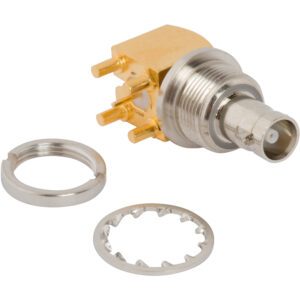
Amphenol RF’s 12G isolated BNC and HD-BNC products are available from Mouser Electronics in both straight and right-angle configurations for additional versatility in the design process. The connectors are engineered with a unique dielectric sleeve that creates the isolated design and prevents any body to panel grounding.
Markets, Sectors, and Applications
Datacom/Telecom, Medical, Military and Aerospace, Test & Measurement, and other markets and applications, including commercial video and radio communications, nuclear instrumentation, and avionics
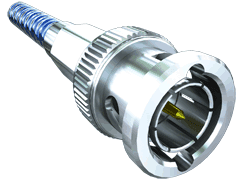
Samtec Inc.’s BNC offerings include 75 Ohm and 50 Ohm BNC miniature quick connect/disconnect RF interfaces like this BNC7T-CA connector.
Suppliers
Amphenol Communications Solutions, COAX Connectors Ltd., Hirose Electric, ITT Cannon, Lemco Precision, Molex, Radiall, Smiths Interconnect, SV Microwave, Times Microwave Systems, Würth Elektronik, Cinch Connectivity Solutions, IMS Connector Systems, JAE, LEMO, Neutrik, Samtec Inc., SOS Engineering, TE Connectivity, Trexon (EZ Form)
Related products:
- SMA Connectors
- RF connector
- SMB connector
- SMC connector
- BNC connector
- TNC connector
- N connector
- Coaxial cable
- Optical fiber connector
- MMCX connector
- MCX connector
Learn more about RF coaxial connectors.
Like this article? Check out our other Meet the Connector, and RF and Coax articles, our Sensors & Antennas Industry Page, and our 2022 Article Archive.
Subscribe to our weekly e-newsletters, follow us on LinkedIn, Twitter, and Facebook, and check out our eBook archives for more applicable, expert-informed connectivity content.
- Where in the World is Amphenol LTW’s Luc Kan? - April 23, 2024
- TE Connectivity’s Sustainability Efforts Pay Off - April 23, 2024
- What is a VGA Connector? - April 23, 2024
